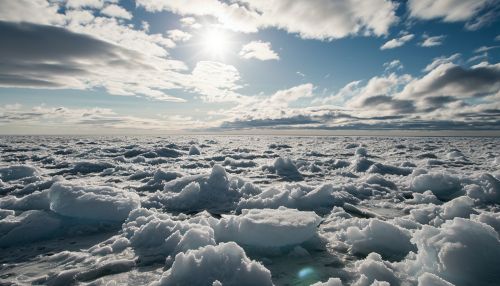First-year ice
Introduction
First-year ice refers to sea ice that has formed in the most recent winter season, and is generally less than one year old. It is a key component of the polar climate system, playing a significant role in regulating global climate, influencing marine ecosystems, and providing a habitat for various Arctic and Antarctic species.


Formation
The formation of first-year ice begins with the freezing of sea water when the air temperature drops below the freezing point. This process is influenced by several factors, including air temperature, wind speed, and the salinity of the water. The initial stage of ice formation results in a thin layer of ice known as nilas. As the freezing process continues, the ice thickens and transforms into first-year ice.
Characteristics
First-year ice is characterized by its thickness, which typically ranges from 30 centimeters to 2 meters. It is less saline than the sea water from which it forms, as the salt is expelled during the freezing process. This results in a lower density and higher buoyancy compared to older ice. The surface of first-year ice is generally smooth and flat, although it can become rough and ridged due to the action of wind and waves.
Role in Climate Regulation
First-year ice plays a crucial role in the regulation of global climate. It reflects a significant portion of the incoming solar radiation back into space, a phenomenon known as the albedo effect. This helps to cool the Earth's surface and lower global temperatures. Additionally, first-year ice acts as a barrier between the ocean and the atmosphere, limiting the exchange of heat, moisture, and gases such as carbon dioxide.
Ecological Significance
First-year ice provides a unique habitat for a variety of Arctic and Antarctic species. It serves as a breeding ground for certain species of seals, and provides a hunting platform for polar bears. The underside of the ice is colonized by ice algae, which form the base of the marine food web in polar regions.
Changes and Impacts
Changes in the extent and thickness of first-year ice have significant implications for climate, ecosystems, and human activities. The reduction in first-year ice due to global warming is contributing to a decrease in the overall extent of sea ice, leading to a decrease in albedo and an increase in ocean temperatures. This has impacts on marine ecosystems, and can also affect human activities such as shipping and resource extraction.
